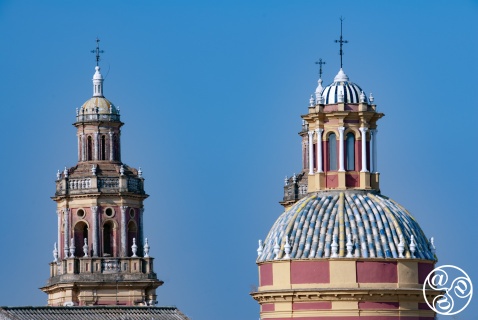
The Convents and Monasteries of Seville |
|
Convents & Monasteries
Seville is a city rich with convents and monasteries. Groups of nuns scuttle down the streets going around their daily business and school girls, dressed in smart plaid skirts and shirts walk in single file throughout the city.
Although there is restricted entry to many of the convents, most are inhabited by closed religious orders. Many of the convents and monasteries are located in La Macarena in the north of the city and which is a characterful mix of decaying Baroque and Mudejar churches, old style neighbourhood tapas bars and washing filled back streets. Its name is thought to derive from the Roman goddess, Macaria, the daughter of the hero Hercules. La Macarena is a traditional district and the power of the church is still strong there.
The best way to enter is to walk north up Calle Feria to the Basilica de La Macarena, a cult-worship shrine to Seville's much-venerated Virgin de la Esperanz Macarena. Beside this modern church stands a restored entrance gate and remnants of defensive walls which enclosed the city during the Moorish era.
Among numerous churches and convents in this quarter, are the Monasterio de San Clemente, the Convento de Santa Paula and the Convento de Santa Clara. Elsewhere in Seville, the Monasterio de Santa Maria de Las Cuevas is well-worth a visit.
MONASTERIOR DE SAN CLEMENTE
Calle Santa Clara 91
The imposing ancient walls of this monastery shield a beautiful cloister with fruit trees and palms. This 13th century was restored for Expo 92 and some galleries and courtyards are open to the public. The church is also accessible and includes a fine example of Mudejar architecture with the finely carved ceiling and tile work dating from 1588. A Baroque main 'retablo' by Felipe de Rivas is also impressive, as well as the 18th century frescoes by Lucas Valdes.
CONVENTO DE SANTA PAULA
Calle Santa Paula 11

Santa Paula Convents
Convento de Santa Paula (c) Michelle ChaplowLooping down towards the river, you reach the Monasterio de Santa Clara, once part of the palace of Don Fadrique, brother of Alfonso X and with a Romanesque - Gothic tower dating from 1252. A couple of blocks away are the distinctive columns of the Alameda de Hercules.
This leads back towards the town centre, with two more churches worth a look on the way, the Renaissance chapel of the Universidad Antigua and Baroque San Salvador, the latter built on the site of Seville's first Friday mosque - part of whose minaret is incorporated in the tower.
CONVENTO DE SANTA CLARA
Calle Santa Clara 40.
This evocative building dates from the 13th century, however unfortunately only the tower of Don Fadrique can be visited these days. The hours are from 9.30 am to 12.30 pm and 17.30 pm to 19.30 pm.
MONASTERIO DE SANTA MARIA DE LAS CUEVAS
La Cartuja (Expo site)
La Cartuja Monastery has links with Christopher Columbus and was later used as ceramic factory. It has been beautifully restored and can be visited. It is also home to the CAAC, the Centro Andaluz de Arte Contemporaneo (Andalucian Centre for Contemporary Art).
Shopping for convent sweets in Granada
An interesting place to buy handmade sweets and pastries is from nuns at the convents of Seville
The "Torno" is a centuries-old method of purchase, where the buyer and the cloistered nun never see each other. The money is placed on a revolving wooden shelf, and the sweets return on the other side. The conversation is often limited to the order and payment.
The Greeting: Traditionally, the buyer would greet the nun with "Ave María Purísima," and the nun would reply, "Sin Pecado Concebida" (Conceived Without Sin). This ritual adds a beautiful historical touch.
Unique Ingredients: Many of these recipes are centuries old and heavily feature almonds, honey, eggs, cinnamon, and sometimes pumpkin (cidra), reflecting both the convent's resourceful, simple life and the region's Moorish (Al-Andalus) culinary past.
Special Occasions: While available all year, sales peak dramatically during Christmas (for treats like mantecados and polvorones) and Holy Week (Semana Santa) (for specialties like torrijas and pestiños).
Convents selling sweets in Seville city
| Convent Name (in Spanish) | Order | Famous Specialties | Buying Method |
|---|---|---|---|
| Convento de San Leandro | Augustinian Nuns | Yemas de San Leandro (egg yolk and sugar sweets), pestiños, muffins (magdalenas) | Traditional torno (lazy Susan) |
| Convento de Santa Paula | Hieronymite Nuns | Jams (mermeladas), quince paste, alfajores mozárabes | Face-to-face counter (often) |
| Convento Madre de Dios | Dominican Nuns | Naranjitos Sevillanos (marzipan with candied orange) | Traditional torno |
| Convento de Santa Ana | Monjas Carmelitas descalzas | Carmelitas, trufas (truffles), mantecados (shortbread) | Traditional torno |
| Convento de Santa Inés | Monjas clarisas | Cortadillos, tortas de aceite (olive oil biscuits), magdalenas | Traditional torno |
| Monasterio de San Clemente | Cistercian Nuns | Marzipan sweets, seasonal specialties | Traditional torno |